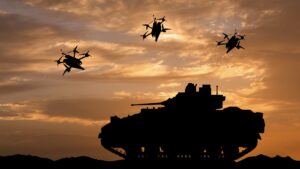Market lift-off? The CEOs of four Aussie drone companies discuss the industry outlook

The business case for drone solutions is still developing across multiple markets. (Pic: Getty)
By now, many Stockhead readers would be broadly familiar with emerging market for commercial drone applications.
And like any emerging market, the challenge for investors has been to identify which companies can build out a profitable business model, across a range of different applications.
With that in mind, Stockhead spoke this week with four companies in the space — three listed and one unlisted.
What emerged was a detailed picture of the different use-cases for drone technology across multiple industries.
And while the industry still has a long way to run — both on the tech side and the regulatory side — the insights they provided offered some useful context for how the sector is shaping up.
Military and defence
Even within the defence industry, drone use-cases vary widely, as evidenced by the two companies we spoke to — DroneShield (ASX:DRO) and Xtek (ASX:XTE).
DroneShield provides equipment and systems to assist in drone defence, while Xtek sells military drones of varying size and capability to the Australian Defence Force.
Coming off a good month in July where the company landed contracts with separate customers in the US and Europe, DroneShield CEO Oleg Vornik told Stockhead he noticed some macro tailwinds in the wake of the COVID-19 disruption.
“I think that’s been driven by several things — one being in the private sector there’s a still lot of caution and reduction in spending. But in the government sector that’s certainly not the case,” he said.
“In fact, governments are ramping up spending — both as a means of stimulating their economies and also to address heightening geo-political tensions.
“So there’s a number of flash-points globally which are driving that, and we’re seeing that translate into strong customer interest in the counter-drone space as well.”
Turning from drone defence to attack, Xtek managing director Philippe Odouard said he had noticed a sharp change in how the Australian military had adopted the use of drone technology.
The company signed its first sales contact with the Australian Defence Force around three years ago, and since then has sold around 65 drone systems
“What’s happening in defence at present time is they’re multiplying the types of drones they’re buying, with different requirements whether you’re in the navy or army,” he said.
“So there’s real tenders going out covering all sizes you can dream of — from an 18-gram device you can carry to what they call the Triton, which has a wingspan of a 757.”
“What they thought would be around three levels (of different drones), they’re now up to around six or seven levels. And each of them have different capabilities — some are more helicopter-like and able to land in narrow areas, others are winged aircraft built for longer endurance.”
“The number of projects there is enormous, and it really went from years of testing to buying in significant quantities now.”
Commercial applications
Along with defence and military, activity is ticking away on the drone market use-case for commercial clients.
Sydney-based Birdi is one local competitor in the space, having established a drone management platform as a way to help business managers get access to drone operators and the resulting data analytics.
Speaking with Stockhead, CEO and co-founder Sebastian Robertson said the platform was spun out of an initial idea to use drones in sport, before pivoting to the business use-case.
He said the company had found traction in a two-tiered market, where companies were either looking to employ drone services while they built out their own capabilities, or pay for the use of a centralised SaaS platform to manage data.
“What we do is standardise that data capture (from drones) and bring it to a central platform,” he said.
“The idea it’s working towards is to create a digital twin — how do you create a digital version of the built environment, so you can better manage and monetise your asset?”
With some early backing from venture capital, Robertson said the company had established a network of almost 2,000 qualified drone pilots across Australia that it outsourced work to.
“It’s almost like an ‘Uber for the sky’ and where we’ve found a way to add value is by managing that data to create insights,” he said.
“It’s all well and good to talk about drones, but what businesses really need are data and insights they wouldn’t have had otherwise.”
As an example, he cited recent work for listed industrials company Boral (ASX:BLD), which was unable to carry out stock measurements at its quarry sites due to the restrictions caused by COVID-19.
“We deployed more than 40 operators over two days at 57 sights across Australia to assess their stockpiles and products on sight, and submitted volumetric reports that allowed them to meet their financial year reporting requirements,” Robertson said.
Communications
The Birdi platform is an example of a business use-case for a broader market that’s based around core drone technology.
Listed players in that space include 3D imaging company Pointerra (ASX:3DP), which recently surged on the back of an investment from tech billionaire Bevan Slattery.
Stockhead also spoke with Mobilicom (ASX:MOB) CEO and co-founder Oren Elkayam about opportunities in the global market for drone-adjacent companies.
The company’s core product offering is based around mission-critical communication components for drones to communicate with each other or send data back to a central database.
Elkayam said the company’s goal was to become a “tier one provider of critical components for drones and robotics”.
“It’s duplicating a business model that exists in the vehicle market. Everyone is familiar with brands like Volvo and BMW. But the real giants of the industry are the tier one component providers like Continental Tyres and Bosch,” he said.
“We are duplicating the same approach to robotics and drones — effectively providing the critical building blocks for drone manufacturers.”
Elkayam said that for drone component manufacturers, the key focus areas would be centred around communication and data security.
And by sector, Mobilicom is geared towards homeland security and defence, along with civilian security and monitoring. “Other operations of drones and robots are less relevant for our technology,” he said.
Elkayam added that the COVID-19 pandemic would help accelerate development in the market as regulators allowed for a “faster evolution”.
“Instead of happening over five years it will happen over three years, and I think defence and homeland security will be the biggest portion of that,” he said.
For their part, the two military companies we spoke to — DroneShield and Xtek — have recently completed capital raises to help fund respective pushes into the US market.
“The reality of the US market is that you can’t really sell into there being based in Australia,” DroneShield’s Vornik said. “You really need a local sales force on the ground to connect with customers and understand how clients think and respond to product demos.”
While on the commercial side, Birdi’s Robertson said Australia offered a sound drone market as a basis for global expansion, similar to other tech success stories such as Atlassian.
“I think one thing people sometimes miss is that Australia as a country is a good adopter of technology,” Robertson said.
“From my observation we can develop good tech here and it offers a great environment to get the model right and then take that model overseas, and I think the plan for our business is to head in that direction.”
Related Topics
UNLOCK INSIGHTS
Discover the untold stories of emerging ASX stocks.
Daily news and expert analysis, it's free to subscribe.
By proceeding, you confirm you understand that we handle personal information in accordance with our Privacy Policy.








